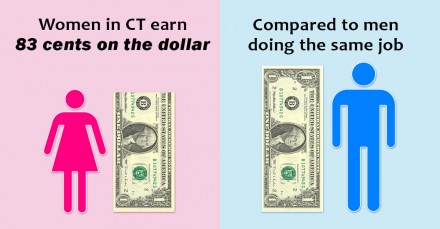
In Connecticut, median annual pay for a woman who holds a full-time, year-’round job is $50,706 while median annual pay for a man who holds a full-time, year-’round job is $60,385, asserts State Rep. Jack Hennessy. The General Assembly’s Labor Committee will conduct a public hearing on Thursday regarding pay equity in the workforce.
More on this from Hennessey:
This means that women in Connecticut are on average paid 83 cents for every dollar paid to men, amounting to an annual wage gap of $10,679.
One of my priority bills this year, Proposed House Bill No. 5591 An Act Concerning Pay Equity in the Workforce, would require employers to provide equal pay to employees in the same workplace who do the same work.
The General Assembly’s Labor Committee is holding a public hearing on the bill on Thursday at 2 p.m. in room 2-A of the Legislative Office Building.
If you can’t make it to the hearing, you can e-mail testimony to labtestimony@cga.ct.gov with the subject line “Testimony on HB 5591.”
The gender pay gap is one of the most important, far-reaching issues we face as a society today. It affects not only working women, but their families and their communities as well.
According to the Center for American Progress, a woman working full-time earns nearly $500,000 less than a man over the course of her career.
The pay gap not only affects a woman’s day-to-day earning, but it also compromises her future retirement. The median income of women 65 and older is 44% less than men in the same age group. Women 75 and older are almost twice as likely as men to be living under the poverty line. This is due, in large part, to the cumulative financial loss years of pay inequality produces.
This gap affects all women, regardless of their level of education. In fact, the higher the level of education, the larger the pay gap grows. Often times, men who are less educated out-earn women with higher degrees. Women with a graduate degree earn an average of $5,000 less than men with a bachelor’s degree.
We have made gains, but progress is slow. At the current rate, we will not fully close the pay gap until 2059. That is why we need legislation like HB 5591. Forty-two years is just too long to wait.
For more information on the gender pay gap, read the report by the Congressional Joint Economic Committee.
As always, please feel free to contact me at (800) 842-8267 or Jack.Hennessy@cga.ct.gov – also please like my Official Facebook Page for news and legislative updates.


Hope his proposal can get a lot of mileage.
That’s very nice Jack, but while you’re doing that why don’t you work on the pay inequality for blacks and whites? Among full- and part-time workers in the U.S., blacks in 2015 earned just 75% as much as whites in median hourly earnings. Women in Connecticut are paid 83 cents for every dollar a man makes, blacks are paid only 75 cents for every dollar a white man makes. I know, I know, let’s work on this first and then we’ll try to narrow the wage gap among blacks and white men because in this America blacks have never been a priority in over 400 years so this isn’t any different.
“in this America blacks have never been a priority in over 400 years so this isn’t any different.”
Wow.
Women are a minority group. Also black women proportionately make less than white women. This is a great start for pay equity and I fully support Rep. Hennessy’s efforts.
“A minority group refers to a category of people differentiated from the social majority, those who hold the majority of positions of social power in a society, and it may be defined by law. Rather than a relational “social group,” as the term would indicate, “minority group” refers to the above-described.”
Every time there is another report of a wage gap between genders, I recall the many research papers done by students in management classes I instructed at UB. One of the more popular topics was the ‘glass ceiling’ or other gender-related issues in the workplace.
Strict guidelines were used for sources they could cite, usually peer-reviewed papers in academic journals and a few other professional periodicals.
Almost without fail, students would cite research published in the Harvard Business Review that shattered some of the ‘glass ceiling’ and gender wage gap arguments. The study conducted about six years ago found that up to the age of about 30 years old, women had higher income than men. The explanation suggested in the study was that women at about age 30 had begun to establish themselves in the workforce but began making career and employment decisions to accommodate family and childcare factors that may last for two decades.
I will try to find the article and forward it to Rep Hennessy. I will also read the report compiled by the Joint Congressional Committee which is likely another example of the old adage that a conclusion you wish to reach can be arrived at if you carefully select the data.